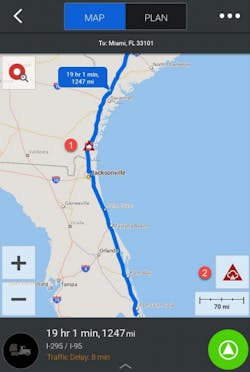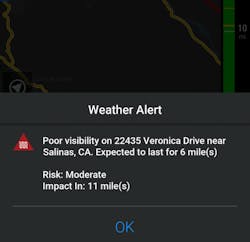Severe weather can cost fleets time, money, and safety: According to the U.S. Department of Transportation, weather causes 3% of commercial truck crashes and leads to fleets losing more than 30 billion hours of driving time annually.
Trimble's CoPilot in-cab navigation app is adding a hyperlocal weather alerting service that will send drivers predictive alerts across routes in North America, company leaders announced during the transportation technology company's recent user conference in Las Vegas.
The alerts will be based on the current forecast and the time the driver is expected to reach that point in the route. Conditions will be retrieved and recalculated as the driver progresses along the route.
See also: Trimble boosts focus on connecting data to find fleet cost savings
Years ago, many fleets that Trimble works with didn't necessarily want weather alerts sent directly to drivers because they'd rather have dispatchers make decisions with drivers. "But that was five, six years ago," he explained. "Fast forward to now, and we're super excited to be adding the weather layer into CoPilot. It's something that we've had for some time—but now we're just really going to refine it and then expose it."
Times have shifted since last decade as drivers want more information, Lazarre said. "Drivers are going to make the ultimate decisions on what they're going to do or what they're not going to do," he explained. "But if you entrust the people in the back office to have the data, they can still make the call. If you give the driver that additional information, the driver can kind of have an idea of what's coming. It's not necessarily to say, 'Hey, stop what you're doing, turn around, and go back.' It's more of an FYI."
How Trimble CoPilot weather alerts work
The risk levels of each weather event will also be displayed, for example:
Moderate: Road conditions due to weather pose a moderate threat to drivers. Weather-related accidents are possible. Drive with caution.
High Danger: Road conditions due to weather pose an increased threat to drivers. Weather-related accidents are likely. Some roadways could be impassable.
Extreme Danger: Road conditions due to weather pose a severe threat to drivers. Weather-related accidents are inevitable, although driving at all may be impossible. Widespread road closures are expected, with an extremely high threat to life.
CoPilot will also display a "Weather Risk Summary" icon for the entire route. This icon provides a high-level overview of how the weather might impact the trip, including the highest risk level the driver is expected to encounter, the maximum and minimum temperatures, and the option to view a list of all weather alerts displayed on the map screen.
CoPilot will issue a weather alert during navigation when the driver is within 10 miles of a weather event. The alert will be displayed as a pop-up message, a warning alert will sound, and the alert will be described via text-to-speech, including how close the alert is to the driver.
According to the company, the new weather alerting service will roll out to Trimble CoPilot customers soon.
About the Author
Josh Fisher
Editor-in-Chief
Editor-in-Chief Josh Fisher has been with FleetOwner since 2017. He covers everything from modern fleet management to operational efficiency, artificial intelligence, autonomous trucking, alternative fuels and powertrains, regulations, and emerging transportation technology. Based in Maryland, he writes the Lane Shift Ahead column about the changing North American transportation landscape.



